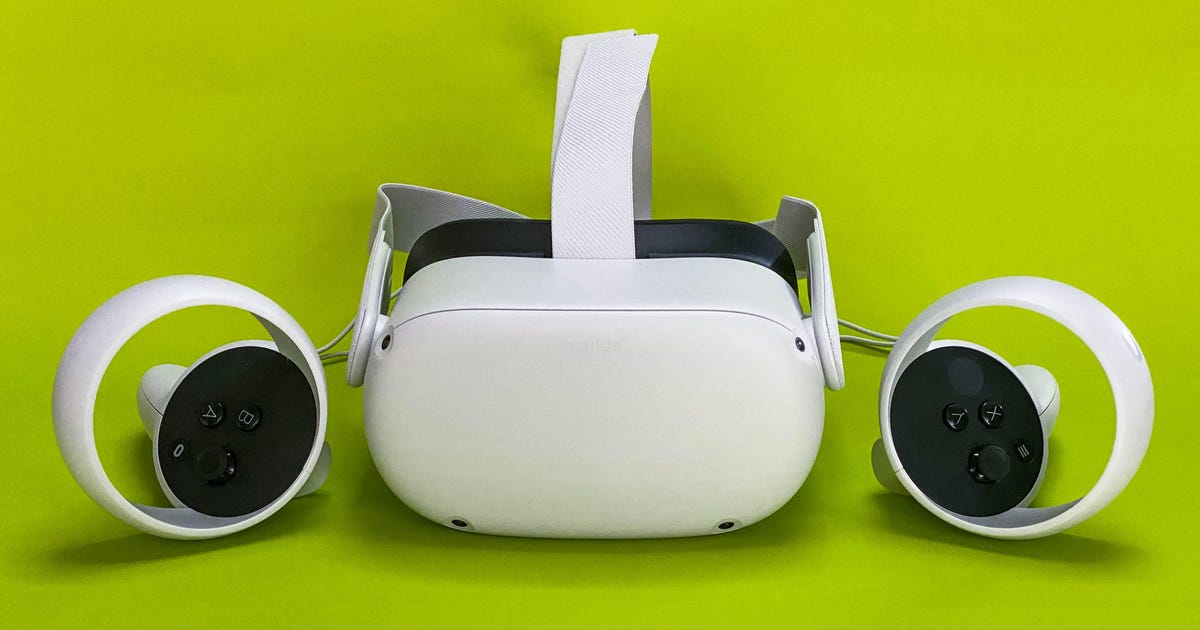
Editor’s note, Aug. 12: The Quest 2 increased in price Aug. 1 by $101. That makes it less of an impulse purchase, but still a CNET Editors’ Choice for now. Below is our updated review.
There’s a pair of magic goggles I’ve gone back to again and again over the last two years, opening up worlds of games, theater, conversations, art and experiences that are tough to even describe. The Meta Quest 2 (formerly, and sometimes still, the Oculus Quest 2) is an improved, less expensive sequel to the 2019 Oculus Quest. It’s already been my portable holodeck, my little magic fitness room, my escape space and one of my favorite game consoles.
However, it’s no longer the budget buy it once was. A surprise $101 increase in the headset’s price means that hardware that used to cost $299 for 128GB of storage and $399 for 256GB is now $400 or $500. That’s a big price jump for aging hardware, even if Meta is offering a free download of Beat Saber as a $30 consolation prize. In a year when everything seems to be getting more expensive, it feels like an unwelcome slap in the face.
Does that mean you should hold off on buying it? All indications are that Meta’s next pro-level VR headset coming later this year will be even more expensive, and a true Quest 3 may not come until 2023 or later. But the reality is, there isn’t any standalone VR headset in existence with the app library or value that the Quest 2 has, even at its higher price.
Like
- High-res display
- Great self-contained gaming experience
- Doubles as PC VR headset
- Works well with a handful of fitness apps
Don’t Like
- $101 more expensive
- Only 2-3 hours of battery life
- Not designed for kids
Meta upgraded the base storage on the entry-level Quest 2 last year, doubling it from 64GB to 128GB. 128GB should be more than enough storage for most, but serious VR gamers will appreciate the 256GB storage tier step-up — there’s no way to expand storage otherwise.
While the Quest 2 is aging, it keeps impressing me. The Quest 2 keeps improving its software: It can get phone notifications, pair with keyboards and connect with virtual meeting apps, do basic fitness tracking and wirelessly stream from PCs. It’s still the best self-contained VR headset right now, and the most affordable for its features.
But, yeah, you have to accept that this is Facebook’s world (and that involves possibilities for future ads, too). While the Quest will soon allow account creation without using a Facebook login, it’s still worth keeping in mind the Quest 2 isn’t designed for kids, even though lots of parents I know have kids who use it. Parental controls are steadily being added, but they’re still not at the level of everyday game consoles like the Nintendo Switch, Xbox or PlayStation.
The Quest 2 has a VR-optimized Qualcomm Snapdragon XR2 processor, a higher-resolution display than the older Oculus Quest and Rift headsets, and it works surprisingly well as a tethered or wireless PC VR headset, in case you need it to.
I find I use the Quest 2 mainly as a game console, or a fitness device, or as a social tool for meeting with friends in virtual worlds. I don’t use it all the time. It’s an experience I dip into once in a while.
If you think of the Quest 2 as a game console, it’s a fantastic little game and experience machine. It might even be my second-favorite game console right now next to the Nintendo Switch. But if you imagine it fulfilling needs for work and the rest of your life, it raises deeper questions and complications.
Oculus Quest 2: How the VR Headset Compares to the First Quest
Mark Zuckerberg and Meta remain focused on trying to turn VR into a better work and connectivity tool, but all of that’s still very much a work in progress. There are work apps in the Quest app library, but none of them work well enough for me to use them. Horizon Worlds and Horizon Workrooms are trying to build out social places for work and play.
Meta’s social media ambitions are clearly aligned where VR and AR are heading, and the Quest 2 still feels like the centerpiece of those efforts. Meta is allowing accounts to bypass needing a Facebook account login soon, but to be clear, you’ll still be under Meta’s umbrella in some way or another.
Read more: Why You Should Buy a Nintendo Switch Lite and Oculus Quest 2, Instead of PS5 or Xbox Series X
More game console than work device
If you treat the Quest 2 as a motion-enabled game console for your face and hands, or a way to socialize with friends in magic worlds where you can run around as invented avatars, it’s fantastic. It’s also a great little machine for playing Beat Saber. The Oculus Quest was already the best self-contained VR headset on the planet, and the Quest 2 is even better.
The experiences I’ve had in Oculus Quest have been surprising and strange, magical and active. The Quest 2 looks to be walking that same path with its curated app store and self-contained ecosystem. The full-motion six degrees of freedom (aka 6DoF) tracking, using four in-headset cameras, is all the same right now. The controllers are complex but well-designed. It’s more of a VR mini game console than anything, but its other tools — virtual big-screen computer monitors, fitness training software, immersive theater portals — could add dimensions you may not even have considered.
There are work tools in the Quest ecosystem, and ways to have virtual meetings: Spatial’s app brings people into shared spaces with workflows and cloud storage tools. Virtual monitor apps like Immerse can turn the Quest into a virtual series of monitors for your real computer. Plug in a USB cable, and the Quest 2 can be a PC VR headset and work with a lot of Steam apps as well. Meta’s Horizon Workrooms shows possibilities, too. I’d still consider these work apps experimental right now, though, and not essential.
Still, the Quest doesn’t really interface with Apple iOS or Google’s Android OS, although it pairs with a phone app like a smartwatch for some basic syncing and screen casting. You can’t just hop into a Zoom call or share a doc, and the flow between my virtual computer work life and the VR virtual flow isn’t there yet. I hope it can arrive because in my opinion, VR headsets should be more like immersive visual headphones. Right now they’re more like customized and different toolkits with positives (physical immersion) and negatives (no face-to-face camera conversation, and no easy work tools like a mouse and keyboard).
A great example of VR’s limits is the Quest 2’s still-evolving hand tracking. I can use my hands to reach out and touch things, controller-free, which is wild. But I can’t get physical feedback, and mastering the specific gestures needed to open an app, drag an object somewhere or type a response to a message feels extremely difficult.

Scott Stein/CNET
What’s excellent
The display resolution: The 1,832×1,920-per-eye pixel resolution is improved from the 1,400×1,600 on the older Quest, and it makes everything smoother, removing a lot of the “screen door” pixelation. The Snapdragon XR2 processor also cuts down on the lower-res halo on the edges of the display that happened previously due to fixed foveated rendering (which only made the center of the display look ultrasharp to help the older processor). It’s more universally clean and crisp now, although there is still some pixelation at the edge of your vision if you look carefully.

Built-in audio pumps up from right behind those straps, but there’s also a headphone jack.
Scott Stein/CNET
Built-in audio doesn’t need headphones: The ambient spatial audio that comes out of the side straps is fine, and I prefer it to using headphones. It sounds a bit better to me than the first Quest. There’s also a 3.5mm headphone jack.
The XR2 chip looks pretty versatile, still: Qualcomm’s XR2 chip remains the best standalone processor for VR at the moment, and VR graphics on recent games have been pretty impressive. The Quest 2 can also handle hand tracking and mixed reality by overlaying virtual objects with its black and white passthrough cameras.
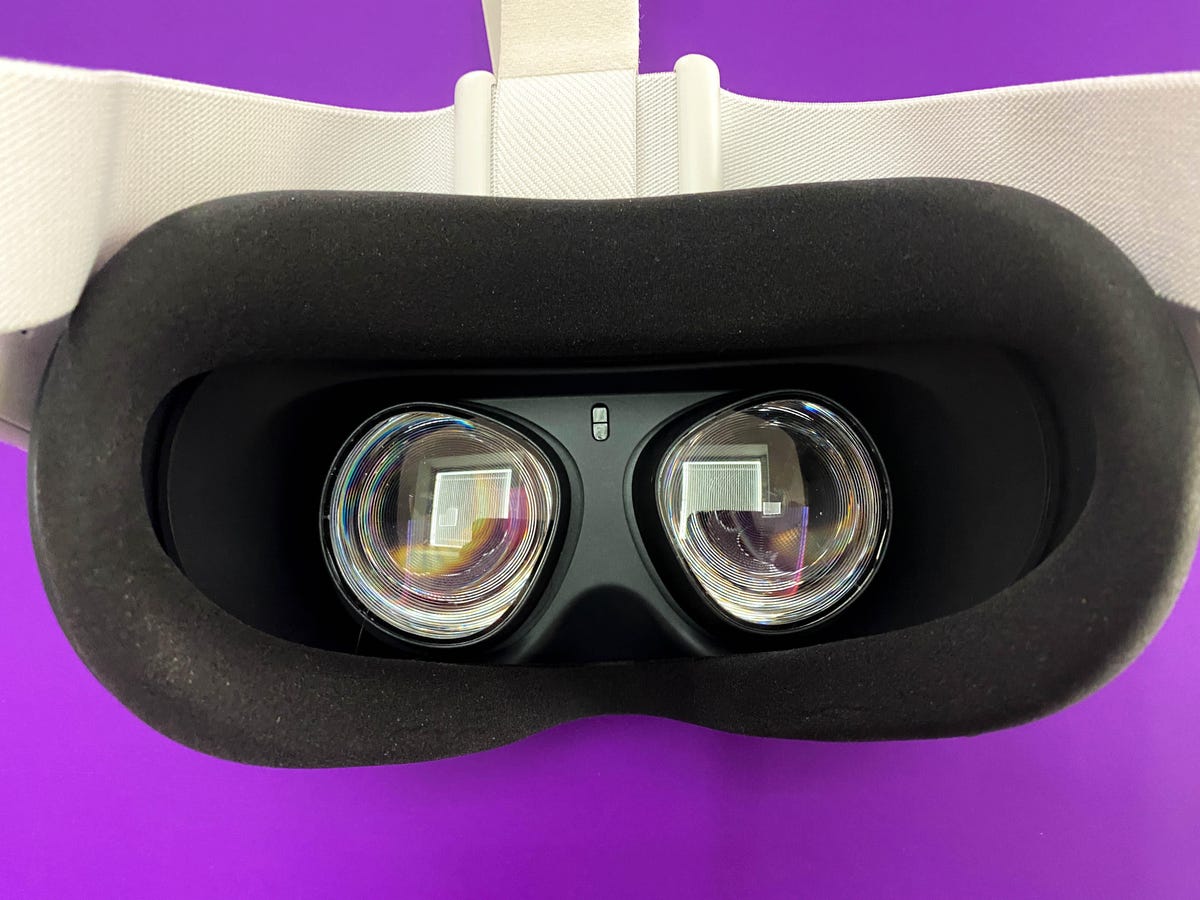
Scott Stein/CNET
The refresh rate is smooth: The first Quest could run at 72Hz, a bit less than PC VR headsets that can go to 90Hz. The faster the refresh rate, the smoother the experience. The Quest 2 can even do 120Hz for some games and apps.
The size and weight aren’t bad: The Quest 2, at 17.7 ounces, or 503 grams, is not super light, but it’s still pretty portable for a self-contained headset. It’s still a pair of goggles, but it’s possible to carry it around. The elastic flex straps are easy to pack down, too, although the Quest 2 still isn’t as portable as an iPad or a Nintendo Switch.
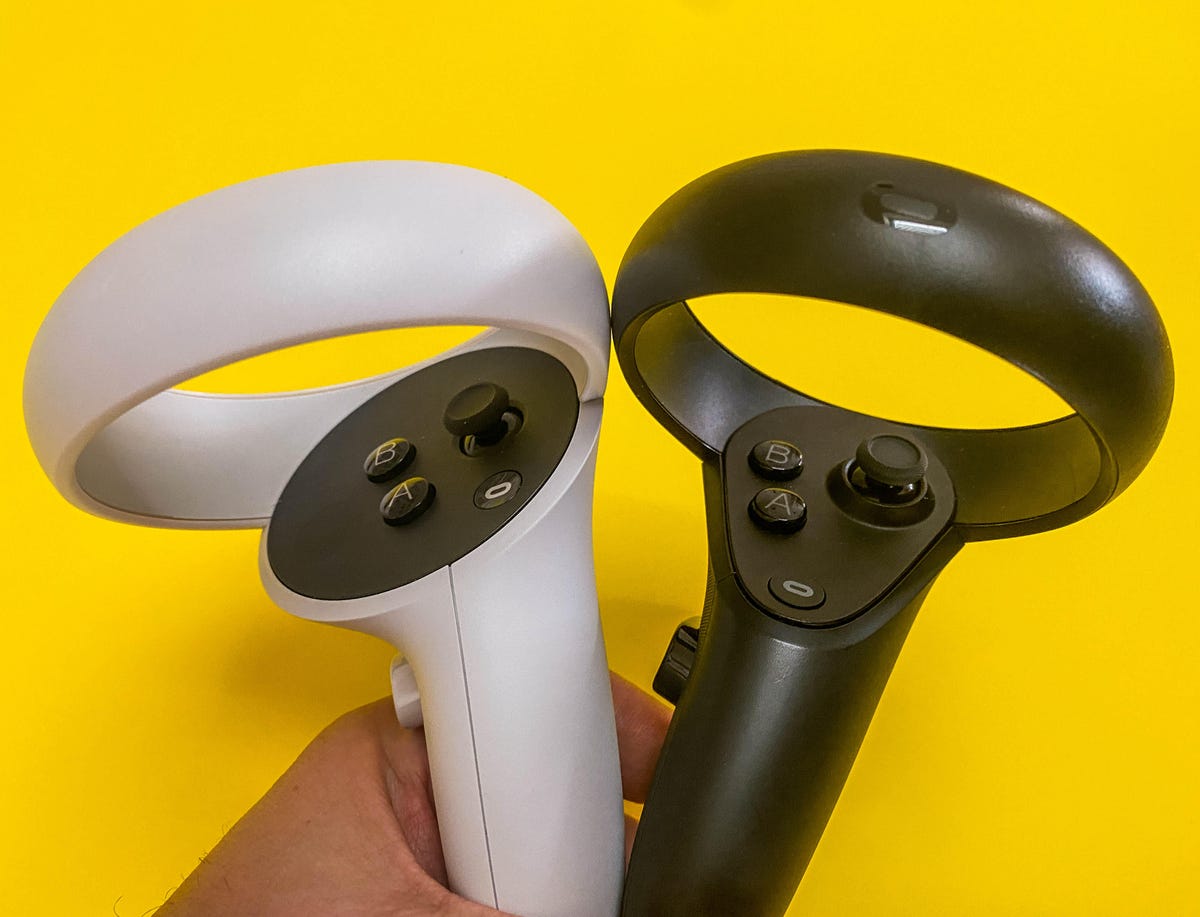
The new Quest 2 controller (left) versus the original Quest (right). Same layout, but there’s more finger-rest room, and the controller’s a bit bigger now.
Scott Stein/CNET
Great controller battery life: The revamped Oculus Touch controllers have the same buttons and analog sticks and triggers, like a split-apart PlayStation controller. But the new controllers are bigger and sturdier-feeling, and have a bigger button area with a thumb rest. The controllers still use AA batteries as opposed to being rechargeable, but last a lot longer on a single battery: Mine lasts on a pair of AA batteries for months. Also, the battery cover doesn’t randomly slide off like it sometimes does on the older Quest controllers.
The game library: The Quest 2 is full of great VR game options. Many of these games can even look as good as their PC versions, although there may come a time in the next year or two when the hardware starts to feel its age.

The elastic straps are more compact now, but sometimes not as comfy.
Scott Stein/CNET
What’s a bit of a letdown
It’s not as friendly to my larger glasses: The eye area on the new Quest is a bit smaller, and the included foam padding feels firmer and cushier. But my glasses now seem a bit more jammed in than on the older Quest. Meta sells a fit pack ($50) with a few different snap-out foam frames for different face types, so maybe I need one of those.
It takes a long time to recharge: The headset lasts two to three hours, which is like the last Quest. I find battery life can run down in just one evening, and then I need to recharge. And recharging takes a long time — an hour or more, which means you’ll need to take a VR break whether you like it or not. Meta does sell an Elite Strap with an extra battery pack, plus a helpful case, which helped my longer-term play sessions a lot.
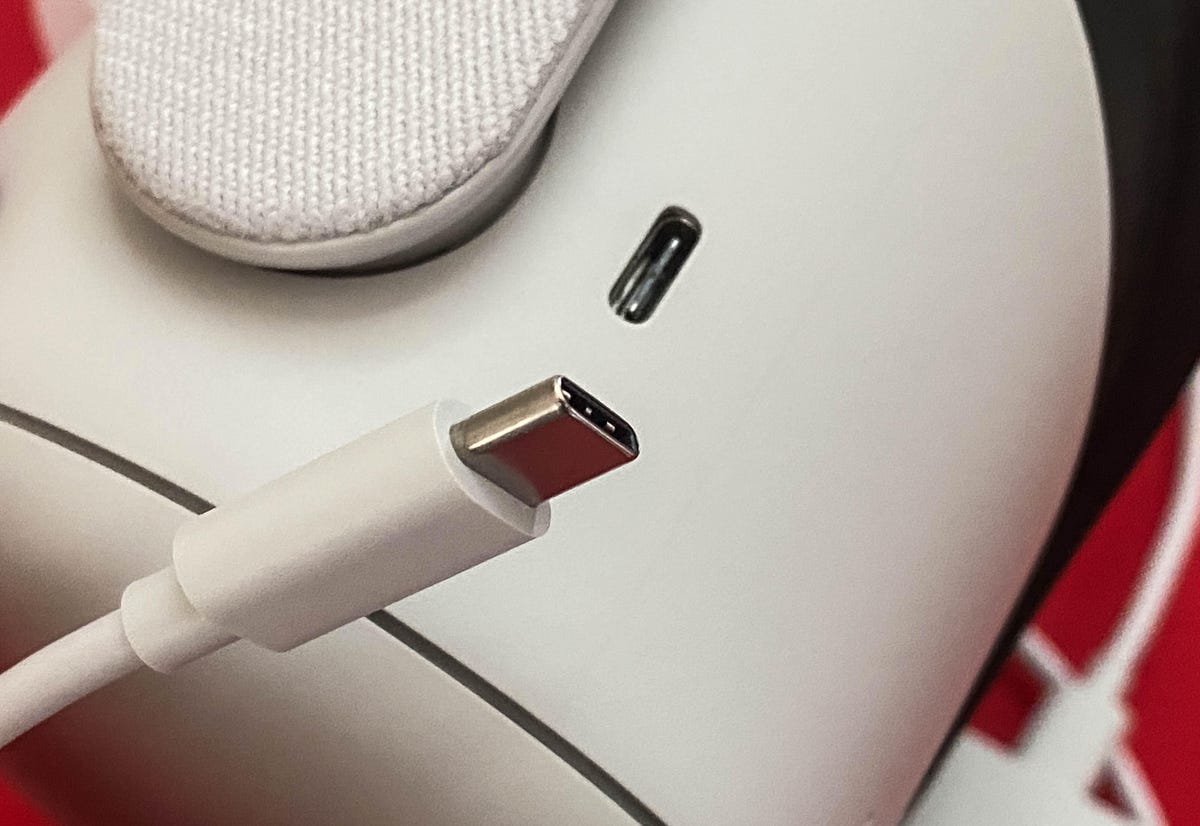
You need a longer USB-C cable to connect to a PC for VR.
Scott Stein/CNET
The included USB-C cable is a lot shorter now: The original Quest included a super long USB-C cable that could be used to charge while playing, or tether via USB-C to a PC. The shorter charge cable with the Quest 2 makes that impossible, but guess what? Meta sells a longer cable for $80 (or you could buy your own for PC tethering via Oculus Link).
No expandable storage: The 128GB on the $400 Quest will hold enough games and apps for most people (a few dozen, roughly). Still, no expandable storage means that you need to choose carefully. Hardcore VR users should consider the 256GB option.
The LCD display’s blacks aren’t as black as the original Quest OLED: The fast-switch LCD on the Quest 2 is generally better, but the black levels are clearly less black. In a darkened virtual movie theater or with a dark game like The Room VR, I’m a lot more aware of the display’s light. (On the upside, bright images and text like web pages seem more vivid.)
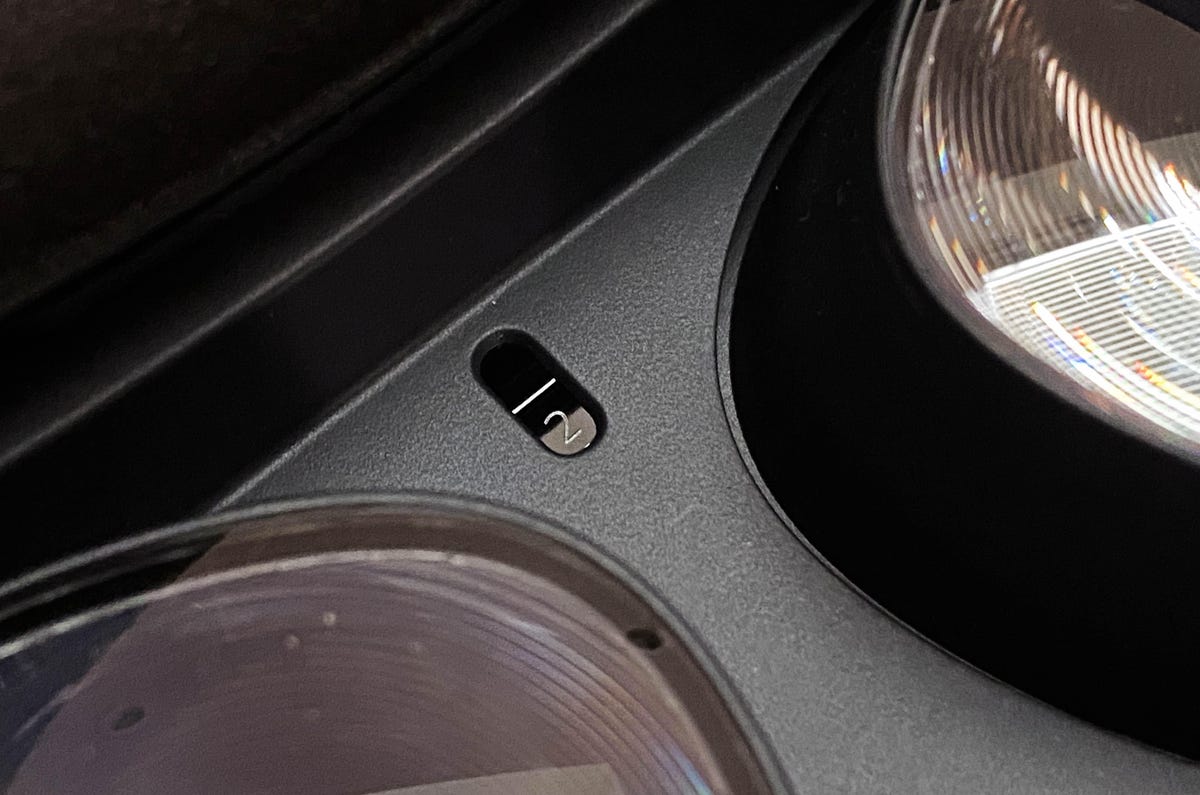
IPD adjustment is one of three fixed settings.
Scott Stein/CNET
IPD adjustment for my eyes was a bit of a learning process: The older Quest fit my eyes perfectly, and also had an interpupillary distance slider to fit eye distances for nearly anyone. The Quest 2 replaces the slider with three preset eye distance settings (53, 63 and 68mm) that are meant to fit most people, but at first my vision didn’t feel 100% with any of them. Over time, I readjusted the straps to my head and started to get better results. I also have thick prescription glasses, FYI.
You can’t really use it in sunlight: The Oculus Quest 2 is like a vampire — keep it indoors. Direct sunlight can cause permanent damage to the displays if beams go through the inner lenses, and when I played outside, the headset tracking had some trouble finding the controllers. It’s a reminder that VR headsets still aren’t everyday take-absolutely-anywhere things quite yet, though I’ve done some outdoorsy experiments from time to time.
A possible magic doorway to more, but what happens next with Meta?
Meta’s road to the future is set toward augmented-reality smart glasses that can blend the virtual and real, but that could still be years off. In the meantime, the Quest 2 could have enough onboard power to evolve new ideas for the company’s immersive work. Its pro-level headset, Project Cambria, should introduce better controllers, more mixed reality, eye and face tracking, and a better display. It could be another bridge to where Meta’s AR ambitions lie, but at a much higher price. The Quest 2, meanwhile, could hang on as a more “budget” device for everyone else.
Besides whatever concerns about Facebook and data you may have, there’s also the question of how open Meta will allow its VR universe to be. While the Quest connects easily with PCs, what about the future of phones? How will the Quest dovetail with the apps we use every day? Right now, it doesn’t. Mark Zuckerberg keeps pledging that the Quest’s future will be open. But the future ahead will be about phones and tablets that plug into VR and AR, and the Quest needs to find a way to be part of that future, too.
For now, the Quest 2 remains a memorable VR and experiential headset, and the best self-contained device VR has ever had. The only question is how much better it can get.
First published Sept. 16, 2020.
